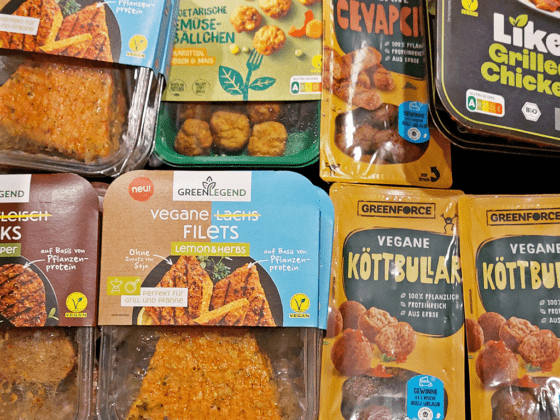Trend
Just a few years ago, “unpackaged stores” felt more like something for super-ecos. In the meantime, things have changed. Some organic chains already offer numerous products such as nuts, pasta or muesli as unpackaged goods. Now large supermarkets are also getting in on the trend. The flustix editorial team presents the new unpackaged concepts – and explains how customers get the naked goods home.
Five years ago, oranges sold peeled and individually wrapped in plastic in a U.S. supermarket earned a mega-shitstorm on the Internet. The fruit marked the peak of an absurd packaging craze. In the meantime, more and more customers no longer want to go along with the eco-insanity. Unpackaged stores are in vogue, but for many people, the choice there is too small, and shopping in several stores is too time-consuming. Now the big retail giants are jumping on the trend – and setting up rice or cereal dispensers in their stores.
Unpackaged stations. Dozens of Edeka stores already have them, as do many tegut stores, eight Kaufland stores and many other discounters: More than 500 supermarkets in Germany now offer their customers loose food, have set up “unpackaged stations” from ecoterra. Interested customers can choose from an assortment of up to 100 (organic) food products and “tap” the food themselves from the dispenser. There is rice, pasta, bulgur and quinoa, as well as nuts, lentils, dried fruit or muesli. Containers are provided – and you can also bring your own.
Here’s how it works: weigh the empty container, stick on the tare label, fill in the desired product without touching it, weigh the container again, enter the product number, enter the tare weight – and you’re done. Finally, affix the label and proceed to checkout, much like shopping for groceries with self-service scales.
The range of products varies from supermarket to supermarket. The first Kaufland stores, for example, offer about 40 foods from the dispenser. Tip: Those interested can find a list of all stores here.
Aldi. The discounter also wants to introduce unpackaged items. The retail giant launched a trial run last year at its Ulverston store in the English province. There, loose products include: Basmati rice, brown rice, penne pasta and fusili. Customers can fill the staples into recyclable paper bags. If the test is successful, Aldi plans to expand the concept to other stores – and could remove more than 130 tons of plastic from its stores each year.


Rewe. The company focuses on “naked” organic fruits and vegetables, launched a pilot with more environmentally friendly packaging in 630 stores in 2019. Peppers are now available with sticky labels instead of plastic packaging, fennel or zucchini with banderoles, or sweet potatoes with organic branding. With such new packaging strategies, REWE aims to avoid 290 tons of waste annually – 5800 tons in total!
Lidl. The food giant is currently working with Swiss researchers at Empa (Swiss Federal Laboratories for Materials Testing and Research) on a particularly clever unpackaged idea: packaging to eat in. It is to consist of pomace from squeezed fruit and vegetable peels and form a kind of protective cover around food. This cellulose layer is to be applied to fruit and vegetables – and can simply be eaten. Bananas can even be kept fresh for a week longer. This prevents both plastic and food waste.

Unpackaged means packaged in a reasonably different way
Of course, we can’t just scatter the rice for dinner on the checkout conveyor belt and then carry it home in our pants pockets. It’s even more complicated with olive oil or beverages. That’s why the new “unpackaged” trend doesn’t mean buying food completely loose, but buying and packaging it in a sensible way other than in disposable plastic. We already know the basic principle from shopping in the fruit and vegetable department, at the meat counter, at the salad bar or at the baked goods shelf.
This is how you carry your unpackaged treasures home:
Paper bag. Can be recycled in the paper waste. For those street smarts, put it in your pocket folded and use one bag multiple times.
Fruit bag. The small handle bags from the roll are made of plastic. But using them multiple times also saves packaging waste. Tip: Stick labels on top of each other on the bag – or temporarily on your wallet.
Reusable nets. You can buy these small white bags with pull straps in almost all supermarkets. Tip: These bags are not only suitable for fruit and vegetables, but also for bread and rolls. They are washable, too.
Loose. Zucchini, fennel or peppers are often just “tied” with a band or marked with a label or organic branding. In this case, the label is simply “milled” into the skin. That’s all the packaging they need.
Glass bottles. Supermarkets don’t have unpackaged liquids yet. But the bottles are suitable for milk vending machines at the farmer’s or stores with food for self-dispensing.
Glass containers or jars. Ideal for shopping at the fresh food counter or at the unpackaged station. Unfortunately, they are comparatively heavy.
Plastic containers. Reusable containers save huge amounts of plastic waste and are lighter than glass containers. The clever ones take their labeled storage containers with them when they go shopping and can put them back in the cupboard when full.
Small changes in packaging sometimes go a long way! Aldi, for example, has already been able to save 120 tons of plastic by now selling organic tomatoes in a box made of renewable grass fiber. And ecoterra did not only start with “unpacked” stations, but now also sells lentils, agave syrup, nuts or gummy bears in deposit jars. When the jars are empty, you simply return them – just like with yogurt from a jar. Kaufland is already offering 90 organic products in deposit jars in its first ten test stores.
But the new trend doesn’t just help avoid plastic waste. There are three other advantages.
Die vier Trümpfe des Unverpackt-Trends
1. Reducing plastic. With new packaging ideas, we can save many tons of plastic packaging.
2. Protecting health. Without packaging, no harmful substances can get into food.
3. Stopping waste. When we buy non-prepacked goods, we only take as much as we need.
4. Saving money. We no longer pay for the production of packaging and its disposal, saving us money on products in bulk that we then have to throw away and buy new.
Many customers have long been ready to stop using plastic when shopping. But until now it has been too inconvenient. For a consumer study by Price, Waterhouse & Co. (PwC), 1,000 customers were asked: “If there were an option to buy groceries without packaging, would you take it?” The result: eight out of ten customers (82 percent) were basically willing to do without packaging when shopping for groceries. However, 63 percent would like to see more packaging-free food available in normal supermarkets. One in three (35 percent) would even prefer a supermarket that only offered packaging-free food.
Now things are finally starting to happen in retail – and hopefully many supermarkets will follow the unpackaged pioneers.
FAQ for the first unpacked purchase
Can I use the reusable nets in a “third-party” supermarket?
Yes, but… Almost all supermarkets now offer their own reusable nets. The polyester nets weigh between 8 and 22 grams, cotton variants even over 50 grams. Although customers only have to pay for the goods, the net is often weighed as well or the weight is not deducted correctly when weighing at the checkout. Tip: With self-service scales, weigh the goods themselves and only then insert them into the net. For goods with unit prices, the nets can of course be used without worry.
Are your own containers at the deli counter or at coffee-to-go a health hazard?
No. Even during Corona times, it is possible to fill containers that you have brought with you and, according to the food association, this does not pose any particular risk. ”If you observe the basic hygiene rules, there is nothing to stop you from continuing to buy in your own containers according to the current state of knowledge,” explains Anja Schwengel-Exner, nutrition expert at the Bavarian Consumer Center. The customer is responsible for ensuring that the container he or she brings along is clean and suitable for the food or drink purchased. Difficult: When filling the containers, staff and the area behind the counter must not come into contact with the customer’s dishes. Many markets use tablets as a disposable base.
Can I insist on using the container I brought for meat or prepared foods?
No, according to the North Rhine-Westphalia Consumer Center, there is no legal right to use packaging that has been brought along. The local food control may also prohibit establishments from refilling containers.
 English
English Deutsch
Deutsch




